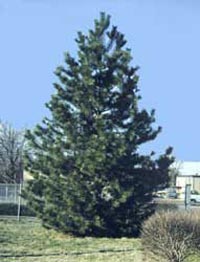Resource Library
Plant of the Week: Austrian Black Pine
The University of Arkansas System Division of Agriculture does not promote, support or recommend plants featured in "Plant of the Week." Please consult your local Extension office for plants suitable for your region.
Plant of the Week
Austrian Black Pine
Latin: Pinus nigra

As the teeth of the chain saw ripped through the trunk of the pine growing beside my house, I thought of the quote from Aldo Leopold: "Hard times come to pines as they do to men."
Leopold, who penned A Sand Country Almanac that encapsulates some of the most distinguished nature writing of the 20th century, said pines will live to be a century old. But my pine was dead near its 30th birthday - struck down in its prime by the travails of life.
The tree was an Austrian black pine (Pinus nigra) that had the potential of reaching 50 feet in height, but mine was only 30 feet tall, a foot for each year of life. If not crowded by its neighbors, it will hold branches to the ground and develop the silhouette of a tubby Christmas tree.
The "black" ascribed to the common name is descriptive, for it is a somber tree. It produces stiff, 4-inch long dark green needles that crowd the stem producing a bottle-brush arrangement on the branches. The tree is a two-needle pine. The bark of the main trunk and branches is often gray-brown or sometimes almost blackish, adding to the somber sentiment.
As the name implies, Austrian black pines are native to Europe. They’re widely distributed through the mountains of southern Europe and Asia Minor. Over this wide range of territory, it varies considerably and many botanical variants have been described. It’s used as a timber species because it’s there, but as such the boards produced tend to be knotty and of low quality.
In our country, the Austrian pine has served only as an ornamental. As such, it’s valuable in its youth but decrepit in its old age. The VA hospital in Fayetteville planted a number of Austrian black pines in the 1930s when the landscape planting was installed. Forty years later I was called in to advise the maintenance crew what to do with the wreck these same trees had become.
Like many trees, Austrian black pines are adaptable and easy to grow for the first 25 years of their life, but once they reach adulthood they begin to suffer. The most common ailment in the South is a pair of fungal diseases called diplodia blight and needle-cast disease.
It starts at the base of the plant and affects the oldest needles first, eventually infecting and then killing those closest to the ground. When the needles are gone, the blight finishes the job and kills the limbs. Spraying, while theoretically possible, is impractical once the trees start their slide into oblivion.
But my pine, and many others in northwest Arkansas, suffered a different end. As I removed the tree, I discovered the hundreds of exit holes of the ips beetle, a bark beetle that attacks stressed conifers. My tree - crowded by mature oaks on two sides - had suffered during the droughts of previous summers.
Two years ago bark beetle scouts cruised the neighborhood when they discovered, probably due to changes in the phenolic chemistry of my struggling tree, their next meal. These scouts then produced a congregation pheromone that attracted a swarm of the tiny brown beetles to lunch at my house.
Will I plant another Austrian pine? Probably not. While this is an attractive young tree, I prefer the notion of planting trees that will outlive me. In cooler climates to our north, it will live longer, so there it should be planted.
By: Gerald Klingaman, retired
Extension Horticulturist - Ornamentals
Extension News - January 31, 2003
The University of Arkansas System Division of Agriculture does not maintain lists of retail outlets where these plants can be purchased. Please check your local nursery or other retail outlets to ask about the availability of these plants for your growing area.
ilk and dairy beef sales total $100 million per year from approximately 420 dairy herds with 40,000 head of milk cows. The Extension Service provides research-based information to producers and industry personnel to help them be more competitive in an increasingly competitive market.
Environmental regulations and the ability to comply with them is a primary concern of producers. Waste management is emphasized in dairy Extension programs.
Since Arkansas and neighboring states normally rank in the bottom few states in the U.S. for production per cow, emphasis is also placed on improving efficiency of production. Forage quality and usage, improved herd management, financial record-keeping (including Dairy Herd Improvement Association records), ration-balancing, and cow comfort, including heat-stress management, are a few subjects addressed by Extension. Sire selection and reproduction are also stressed because the genetic levels of the herd and overall fertility have marked effects on net profit of the herd.
The state of the U.S. and international dairy industry may see changes that are even more dramatic in the future. The ongoing reorganization of federal milk marketing orders and shifts in milk production areas within the U.S. make Extension educational efforts even more critical to improving efficiency of milk production for both dairy producers and consumers.